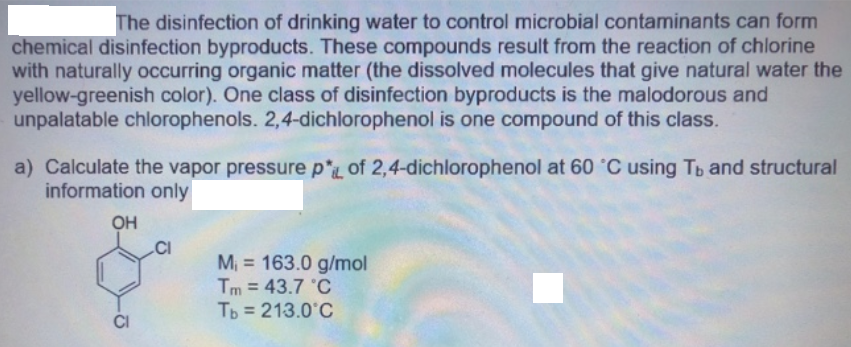The disinfection of drinking water to control microbial contaminants can form chemical disinfection byproducts. These compounds result from the reaction of chlorine with naturally occurring organic matter (the dissolved molecules that give natural water the yellow-greenish color). One class of disinfection byproducts is the malodorous and unpalatable chlorophenols. 2,4-dichlorophenol is one compound of this class. a) Calculate the vapor pressure p*L of 2,4-dichlorophenol at 60 °C using Tb and structural information only OH .CI M, = 163.0 g/mol Tm = 43.7 °C Tp = 213.0°C %3D %3D %3D
The disinfection of drinking water to control microbial contaminants can form chemical disinfection byproducts. These compounds result from the reaction of chlorine with naturally occurring organic matter (the dissolved molecules that give natural water the yellow-greenish color). One class of disinfection byproducts is the malodorous and unpalatable chlorophenols. 2,4-dichlorophenol is one compound of this class. a) Calculate the vapor pressure p*L of 2,4-dichlorophenol at 60 °C using Tb and structural information only OH .CI M, = 163.0 g/mol Tm = 43.7 °C Tp = 213.0°C %3D %3D %3D
Organic Chemistry
8th Edition
ISBN:9781305580350
Author:William H. Brown, Brent L. Iverson, Eric Anslyn, Christopher S. Foote
Publisher:William H. Brown, Brent L. Iverson, Eric Anslyn, Christopher S. Foote
Chapter23: Amines
Section: Chapter Questions
Problem 23.67P
Related questions
Question

Transcribed Image Text:The disinfection of drinking water to control microbial contaminants can form
chemical disinfection byproducts. These compounds result from the reaction of chlorine
with naturally occurring organic matter (the dissolved molecules that give natural water the
yellow-greenish color). One class of disinfection byproducts is the malodorous and
unpalatable chlorophenols. 2,4-dichlorophenol is one compound of this class.
a) Calculate the vapor pressure p*L of 2,4-dichlorophenol at 60 °C using Tb and structural
information only
OH
.CI
M, = 163.0 g/mol
Tm = 43.7 °C
Tp = 213.0°C
%3D
%3D
%3D
Expert Solution
This question has been solved!
Explore an expertly crafted, step-by-step solution for a thorough understanding of key concepts.
This is a popular solution!
Trending now
This is a popular solution!
Step by step
Solved in 2 steps

Recommended textbooks for you

Organic Chemistry
Chemistry
ISBN:
9781305580350
Author:
William H. Brown, Brent L. Iverson, Eric Anslyn, Christopher S. Foote
Publisher:
Cengage Learning

Chemistry: An Atoms First Approach
Chemistry
ISBN:
9781305079243
Author:
Steven S. Zumdahl, Susan A. Zumdahl
Publisher:
Cengage Learning


Organic Chemistry
Chemistry
ISBN:
9781305580350
Author:
William H. Brown, Brent L. Iverson, Eric Anslyn, Christopher S. Foote
Publisher:
Cengage Learning

Chemistry: An Atoms First Approach
Chemistry
ISBN:
9781305079243
Author:
Steven S. Zumdahl, Susan A. Zumdahl
Publisher:
Cengage Learning


Chemistry
Chemistry
ISBN:
9781305957404
Author:
Steven S. Zumdahl, Susan A. Zumdahl, Donald J. DeCoste
Publisher:
Cengage Learning

Principles of Modern Chemistry
Chemistry
ISBN:
9781305079113
Author:
David W. Oxtoby, H. Pat Gillis, Laurie J. Butler
Publisher:
Cengage Learning